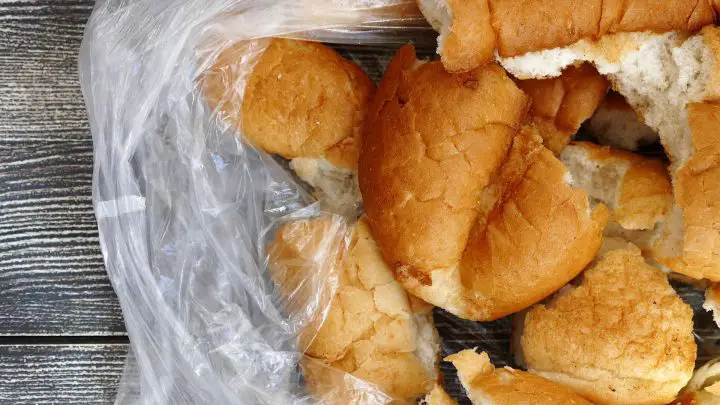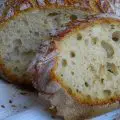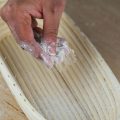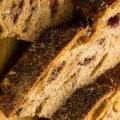Sourdough bread has certainly become a favorite choice of bread in my household! But it wasn’t always easy to bake, as with sourdough baking comes incredible patience, and waiting! If you’ve ever had the misfortune of experiencing underproofed sourdough, then here’s what you need to know.

Table of Contents
- What Does Proofing Mean in Sourdough?
- What Happens If Sourdough Is Underproofed?
- Signs of Underproofed Sourdough
- How to Fix Under-Proofed Sourdough
- Can You Eat Underproofed Sourdough?
- Underproofed Sourdough 101
- FAQs
What Does Proofing Mean in Sourdough?
Proofing is an essential step in the world of baking. This is when the dough is made to rest, and rise one last time before baking. During this period, the yeast ferments the dough and produces pockets of gas, which help make the dough nice and airy. Proofing gives your sourdough bread large pockets of air, with a light interior, which is what gives it the beautiful open crumb structure.
These pockets of gas expand and push against the gluten strands set up by kneading the dough. This ensures that the gasses remain contained, although the continuous expansion is very apparent in the large holes of the sourdough crumb when the bread is finely sliced.
What Happens to Sourdough During Proofing?
Proofing enables the sourdough loaf to rest and the dough rises one last time before baking. During this time the yeasts from the sourdough starter work to help ferment the dough and produce gasses which eventually help leaven the dough.
How To Tell If Sourdough Is Done Proofing
Understanding when your sourdough has done proofing will help save your bread from becoming dense and gummy.
You can test whether your bread has done proofing by poking the dough lightly with your finger. If the dough bounces back, and the indentation disappears, then it is not ready yet, and may need to proof for a bit longer. If the indent doesn’t bounce back, then your loaf is over-proofed. If your dough springs back slowly and leaves a small indent, then it is ready to bake.
Ideally, your dough should have doubled in size compared to the first rise.
What Happens If Sourdough Is Underproofed?
One of the worst outcomes of sourdough bread is an underproofed sourdough bread. This is when there isn’t enough carbon dioxide in the sourdough for it to create much rise, which is why you may find this evident in your baked sourdough bread. The crumb structure suffers the most. You’ll find to your disappointment that it is tight with a gummy texture. Underproofed bread is an indication of insufficient carbon dioxide gasses in sourdough. Resulting in very dense bread with uneven air bubbles.
Signs of Underproofed Sourdough
During bulk fermentation, you’ll need to keep a close eye on your dough, as this will help you judge how much time your sourdough needs to remain before baking. Here are some of the signs you need to look out for:
- Little volume: If your dough hasn’t increased in volume by at least 50% then your dough is under-proofed. Be sure to give it some more time to proof before taking it to the oven.
- No jiggle: Dough that is underproofed won’t have a jiggle to it. You can test your dough, by gently shaking the bowl side to side. If your dough jiggles then it is ready. If there’s no jiggle then your dough needs more time to build those gas bubbles.
- Little to no gas bubbles: Large glass bubbles will gather on the top and sides of the bowl. These are a great way to indicate whether your sourdough has finished proofing. If you see little to no bubbles then your dough needs more time.
How to Fix Under-Proofed Sourdough
To fix under-proofed sourdough you will must first recognize the actual outcome of a proofed sourdough. A sufficiently proofed dough will have doubled in size, compared to what it had initially started with. Generally, if you’re afraid that your sourdough hasn’t proofed enough, then let it rest for a little longer, and monitor the dough. Wait for the dough to double in volume, as this is where the gasses will work their magic, in helping to generate that perfect airy sourdough crumb.
Under proofed sourdough may signify a problem with the yeasts in your sourdough starter. For instance, if you’ve tried to activate your starter, with flour and hot water, the starter may not react with the flour like it was supposed to, resulting in a faulty starter.
You’ll need to fix your sourdough starter before proceeding, as a problem with a starter, generates a problem in your dough, resulting in dense, gummy, and heavy sourdough loaf.
Can You Eat Underproofed Sourdough?
Yes, you can. However, you may notice that the taste and texture of the under-proofed loaf are rather unpleasant. As long as you’ve ensured that the loaf has cooled completely before slicing it in half, it should be completely fine to eat. Although, if your under proofed loaf is more gummy, moist, or completely uncooked inside, in which case it’s best to throw it away.
If your concern surrounds the overall appearance of the bread, then you can easily enjoy the tasty benefits of your loaf instead.
Underproofed bread imparts a slightly sour and underdeveloped taste, unlike perfectly proofed sourdough bread.
Underproofed Sourdough 101
It’s important to monitor your sourdough before deciding whether it’s ready to pop in the oven for the big bake. Your sourdough should show signs of readiness through a sufficiently risen dough, indicating lots of gas bubbles, and promising the perfect crumb.
FAQs
What Temperature And Time Should You Proof Sourdough?
You should aim to proof your sourdough between 75-85F for 1-2 hours.
How Do I Tell If My Sourdough Has Bulked Enough?
The best way to tell if your sourdough has completed bulk fermentation is to grab the bowl and shake it slightly. If the dough jiggles slightly, then this indicates that the dough is strong enough and ready to be divided.
How Can I Make My Sourdough Bread Have More Holes?
The appearance of holes is an indication of sufficient carbon dioxide in your dough. For this you’ll need to create a strong dough, that rises enough to form large gas pockets. A higher hydration dough will do the job nicely, coupled with a long fermentation, and very gentle handling. You should also aim to use strong flour to encourage stronger gluten.
What Happens When You Underproof Bread?
Underproofed dough will risk the dough continuing to rise while it bakes. This will cause tears in the crust, and produce a loaf with a tight and gummy interior.
What Happens If You Don’t Proof Dough?
If you don’t allow your dough to be proof enough, then the resultant loaf will be dense, rubbery, and unpleasant. It’s important for the dough to proof, to enable the gasses to fill the bread and provide it with its distinct airy texture.
How to Fix Under-Proofed Dough
If you catch it just in time then it is easily fixable. Simply give it an extra long rest before the final shape.




![How To Stretch And Fold Sourdough [A Detailed Guide] 5 How to stretch and fold sourdough [a detailed guide]](https://www.mydailysourdoughbread.com/wp-content/uploads/2023/06/How-To-Stretch-And-Fold-Sourdough-120x120.jpg)
